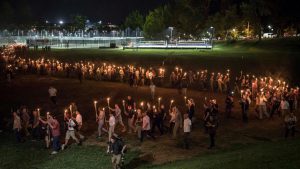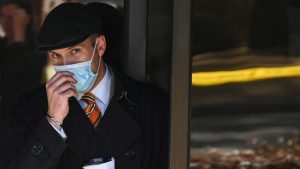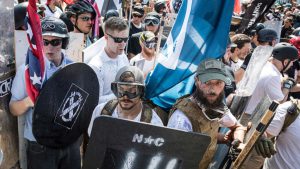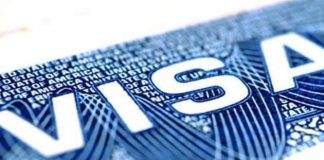NOVEMBER 23, 2021

CHARLOTTESVILLE, VIRGINIA — Jurors on Tuesday found the main organizers of the deadly right-wing rally in Charlottesville, Va., in 2017 liable under state law for injuries to counter protesters, awarding more than $25 million in damages. But the jury deadlocked on two federal conspiracy charges.
The verdict in the civil trial, though mixed, was a rebuke for the defendants — a mix of white nationalists, neo-Nazis and Confederate sympathizers. They were found under Virginia law to have engaged in a conspiracy in the lead-up to the rally, which began as protest over the removal of a Confederate statue and resulted in a car attack that killed one counter protester, 32-year-old Heather Heyer.

All nine plaintiffs testified that they suffered from post-traumatic stress disorder because of the violence during the rally. – Matt Eich /NY Times
The case in U.S. District Court in Charlottesville was brought by nine plaintiffs, four men and five women, including four people injured in the car attack. In addition to their physical injuries from the crash, including three concussions and a skull fracture, the plaintiffs testified that they suffered from post-traumatic stress disorder, including insomnia, the inability to concentrate, flashbacks and panic attacks.

Richard Spencer, a defendant in the case, leaving federal court in Charlottesville, Va., during the trial. – Kenny Holston/NY Times
All were seeking compensatory and unspecified punitive damages, including payment for medical costs as well as $3 million to $10 million for pain and suffering depending on the degree of their injuries.
They said that in addition to holding march organizers responsible for the violence, they hoped to deter hate groups from mounting similar toxic spectacles in the future, relying on civil suits in the absence of decisive action by the criminal justice system.
The rally, which featured extremists carrying torches and chanting racist slogans, was organized as a protest against the removal of a statue of Robert E. Lee that has since been dismantled. But its broader aim was to move the far right from the internet fringes into the mainstream.
The federal charges on which the jury deadlocked related to whether the defendants had engaged in a race-based violent conspiracy, which is illegal under an 1871 federal law known as the Ku Klux Klan Act that was designed to prevent vigilantes from denying newly freed slaves their civil rights. The plaintiffs said they would consider seeking a retrial on the federal charges.
Numerous defendants readily admitted their racial animosity, but said they were exercising their First Amendment rights with a legal permit for the rally, not participating in a conspiracy to commit violence. They blamed the violence entirely on James Fields, a demonstrator who mowed down counterprotesters with his car, killing Ms. Heyer. A defendant in this case, he was already serving multiple life sentences.
The jury was asked to decide whether each of the defendants had engaged in a conspiracy, and, if so, what compensation should be paid to the plaintiffs.
The jury began deliberating on Friday. The 77 pages of instructions from the judge explained how engaging in a conspiracy did not require all participants to forge an agreement or meet in the same room, or even to know one another. Nor did a conspiracy require the participants to have caused the violence themselves. The main point was that they all shared an objective and could foresee the violence that occurred.
The plaintiffs drew a line from Mr. Fields through all the organizations that participated, linking him first to Vanguard America, the group that he marched with in Charlottesville, and then to the other organizations and their leaders. The defendants argued that it was all just a pile of online chatter that did not amount to strong connections, much less a conspiracy, among those involved. Nobody knew Mr. Fields beforehand, they stressed, and he was not involved in organizing the event.

Rioters during the rally in Charlottesville in 2017. – Edu Bayer/NY Times
The four-week trial, long delayed because of the coronavirus pandemic, underscored how much the rally organizers and their groups were already sidelined, squabbling among themselves and financially strapped in the wake of the violent debacle in Charlottesville. Richard Spencer, the most high-profile leader of the alt-right at that time, who defended himself during the trial, described the case in 2020 as “financially crippling.” Seven defendants ignored the proceedings and will be dealt with separately by the court.
The unspecified punitive damages were meant as a deterrent against any similar rally again, said Roberta Kaplan, the lead attorney who organized the case through a non-profit organization called Integrity First for America.
But if many players have been shunted aside, the ideology has not. In recent decades, whenever far-right groups have lost in court, the movement has rebounded.
“While some of the messengers have been eviscerated, the more mainstream versions of their hatemongering continue to have real currency, with broad exposure guaranteeing that the violence of the far-right fringes will unfortunately continue,” said Brian Levin, the director of the Center for the Study of Hate and Extremism at California State University, San Bernardino.
In seeking to prove that the violence was foreseeable, the plaintiffs highlighted how often the idea of hitting protesters with cars came up beforehand.
Samantha Froelich, who was dating two of the main organizers simultaneously in the leadup to the rally, but who has since left the movement, testified that hitting protesters with cars was discussed at a party earlier that summer in the “Fash Loft,” short for fascist, the nickname for Mr. Spencer’s apartment in Alexandria, Va.
After the violence, Matthew Parrott — one of the leaders of the since disbanded Traditionalist Workers Party, which was modeled after the Nazi Party — and the others celebrated. “Charlottesville was a tremendous victory,” he said in a post. “The alt-right is not a pathetic and faceless internet fad, but a fearsome street-fighting force.”
While the plaintiffs’ case took three weeks and 36 witnesses, the defendants rested after a day and a half.
The defendants made four broad arguments. First, they argued that while others might deplore their views, the First Amendment allowed them. Second, that they acted in self-defense. Third, that the police were to blame for not keeping the opposing sides apart. Fourth, that none of them could anticipate what Mr. Fields did because none knew him.
The trial brought to life the hatred and anger espoused by the far-right groups, especially on the streets of Charlottesville. A torch-lit march on the eve of the rally, with hundreds of men chanting racist slogans, evoked Ku Klux Klan and Nazi marches. The testimony as well as the many videos and social media posts introduced were awash in the iconography of hate, with Nazi symbols and stiff-armed salutes, with admiration for Hitler and claims that nonwhite races were inferior.
Supporters of the defendants maintained a cheering section online full of expletive-laced rants against Black and Jewish people, while the defendants themselves weighed in with commentary. In an online interview, Michael Hill, 69, president of the League of the South, which seeks to establish a white ethno-state, called the courtroom a “front line” in the battle.
While testifying, Mr. Hill was asked to read part of a pledge that he had posted online. “I pledge to be a white supremacist, racist, antisemite, homophobe, a xenophobe, an Islamophobe and any other sort of phobe that benefits my people, so help me God,” he read with apparent enthusiasm. He added: “I still hold those views.”
Lawyers for the white supremacists had argued that such messages of hate were not enough to prove the plaintiffs’ case.
“They’ve proven to you that the alt-right is the alt-right — they are racists; they are antisemites,” James Kolenich, one of the defense lawyers, said in closing arguments. “But what does that do to prove a conspiracy?”
During the trial, Judge Norman K. Moon said that in a criminal case a jury would have to find guilt “beyond a reasonable doubt,” but that in this type of civil case they needed to determine that a “preponderance of evidence,” that is more than 50 percent, buttressed the accusations.










































































































